For a bright brunch dish, serve the dressed fruit salad over thick Greek yogurt or Icelandic skyr.
Ingredients
- 4 cups mixed fruit, such as chunks of melon and mango, sliced strawberries, red grapes, blueberries, and pineapple cubes
- 3 tablespoons extra virgin olive oil
- 2 tablespoons honey, preferably orange blossom
- Zest and juice of 1 medium lime
- 2 tablespoons finely chopped fresh spearmint or peppermint leaves
- 1 tablespoon calamansi or other citrus-based vinegar (optional)
Directions
Place the fruit in a large mixing bowl. In a small bowl, whisk together the olive oil, honey, lime juice and zest, mint, and optional vinegar. Pour the dressing over the fruit and toss gently. Allow to macerate for 30 minutes. Toss again before serving.
Serves 6




